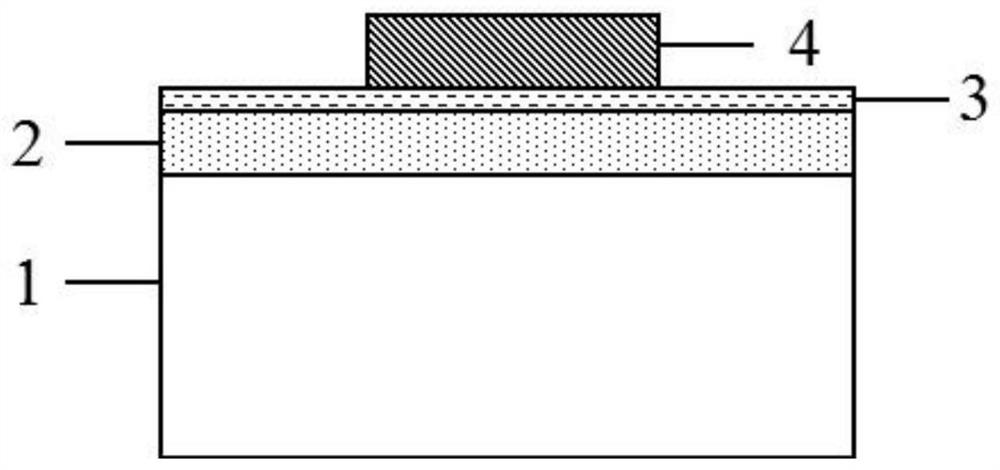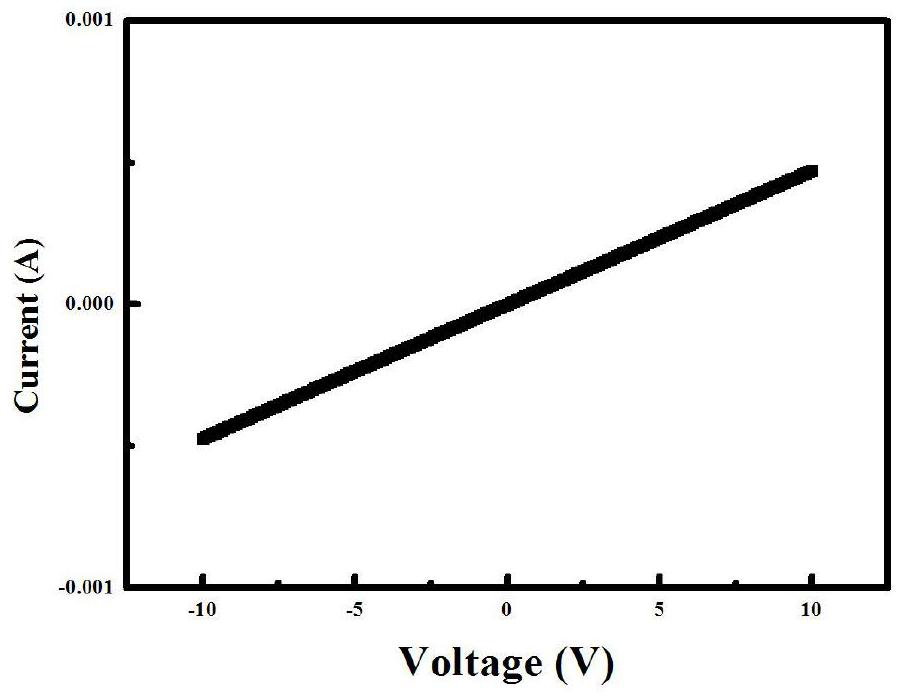A method for forming ohmic contact of (100) oriented n-type single crystal diamond electrode
A single crystal diamond, ohmic contact technology, applied in the direction of circuits, electrical components, semiconductor devices, etc., can solve the problems of high contact resistivity, difficult ohmic preparation, etc., to achieve lower specific contact resistivity, lower requirements, and good ohmic contact Effect
- Summary
- Abstract
- Description
- Claims
- Application Information
AI Technical Summary
Problems solved by technology
Method used
Image
Examples
Embodiment 1
[0031] Such as figure 1 , a (100) oriented n-type single crystal diamond electrode ohmic contact forming method, (100) oriented n-type single crystal diamond 1 is a self-supporting body material with a size of 3 × 3 × 0.3mm 3 , with a surface roughness of 1 nm. A 10nm-thick n-type diamond epitaxial thin layer 2 was epitaxially grown on its surface by MPCVD, and the growth conditions were: air pressure 100 Torr, gas flow rate 500 sccm, CH 4 / H 2 = 1%, PH 3 / CH 4 =0.1%, and the substrate temperature was 900°C. After the growth, the sample was placed in a 1:1 mixture of sulfuric acid and nitric acid, heated at 250 °C for 1 h to convert the surface hydrogen terminals into oxygen terminals, and annealed at 900 °C for 5 min to obtain a highly conductive diamond surface 3. Through photolithography, magnetron sputtering, and lift-off processes, W metal electrodes 4 are prepared on the high-conductivity diamond surface 3, and then annealed at 400° C. for 10 minutes in an argon atm...
Embodiment 2
[0033] Such as figure 1 , a (100) orientation n-type single crystal diamond electrode ohmic contact forming method, (100) orientation n-type single crystal diamond 1 is a single crystal thin film, the size is 10 × 10 × 0.001mm 3 , with a surface roughness of 2nm. The n-type diamond epitaxial thin layer 2 with a thickness of 100nm is epitaxially grown on its surface by MPCVD method, and the growth conditions are: air pressure 100Torr, gas flow rate 500sccm, CH 4 / H 2 = 1%, PH 3 / CH 4 = 1%, and the substrate temperature was 900°C. After the growth, the surface hydrogen terminals were transformed into oxygen terminals by ultraviolet ozone treatment, and annealed at 1100° C. for 5 minutes to obtain a highly conductive diamond surface 3 . Prepare Ti / Pt / Au metal electrodes 4 on the high-conductivity diamond surface 3 by photolithography, magnetron sputtering, and lift-off processes, and then anneal at 700° C. for 20 minutes in an argon atmosphere to form ohmic contacts.
Embodiment 3
[0035] Such as figure 1 , a (100) orientation n-type single crystal diamond electrode ohmic contact forming method, (100) orientation n-type single crystal diamond 1 is a self-supporting body material, the size is 5 × 5 × 0.5mm 3 , with a surface roughness of 2nm. A 50nm-thick n-type diamond epitaxial thin layer 2 was epitaxially grown on its surface by MPCVD method, and the growth conditions were: air pressure 100 Torr, gas flow rate 500 sccm, CH 4 / H 2 = 1%, PH 3 / CH 4=0.5%, and the substrate temperature was 900°C. After the growth, the sample was placed in a 1:1 mixture of sulfuric acid and nitric acid, heated at 250 °C for 1 h to convert the surface hydrogen terminals into oxygen terminals, and annealed at 1000 °C for 10 min to obtain a highly conductive diamond surface 3. Prepare Ti / Au metal electrodes 4 on the highly conductive diamond surface 3 by photolithography, magnetron sputtering, and lift-off processes, and then anneal at 550°C for 20 minutes in an argon atm...
PUM
| Property | Measurement | Unit |
|---|---|---|
| surface roughness | aaaaa | aaaaa |
| thickness | aaaaa | aaaaa |
| surface roughness | aaaaa | aaaaa |
Abstract
Description
Claims
Application Information
 Login to View More
Login to View More - R&D
- Intellectual Property
- Life Sciences
- Materials
- Tech Scout
- Unparalleled Data Quality
- Higher Quality Content
- 60% Fewer Hallucinations
Browse by: Latest US Patents, China's latest patents, Technical Efficacy Thesaurus, Application Domain, Technology Topic, Popular Technical Reports.
© 2025 PatSnap. All rights reserved.Legal|Privacy policy|Modern Slavery Act Transparency Statement|Sitemap|About US| Contact US: help@patsnap.com


